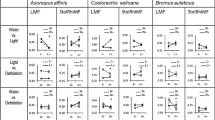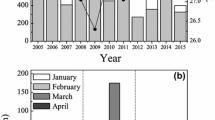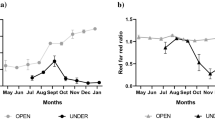Abstract
Microsite influences on resource allocation related to silvopastoral swards undergoing repeated defoliation are unclear. Defoliating traditional pasture species according to canopy development criteria may not be appropriate when the plants grow as understory crops in woodlots. An experiment using container-grown plants was conducted under field conditions to determine how open (O), shaded woodland (W) and open-to-shaded woodland transition zones (E O, E W), representing the partial shade conditions found in silvopastoral settings, influenced productivity and dry matter allocation in Dactylis glomerata L. Plants established in spring (SP) and late summer (LS) were clipped each time mean sward height reached 20 cm. Dry matter production differed for SP and LS plantings, and was greater in O than W sites. Dry matter allocation to shoots of SP plants indicated some agronomic benefit associated with the E O and E W sites. Leaf mass did not vary with irradiance, but stembase mass did. The SP plants had numerous small tillers whereas LS plants were composed of comparatively fewer but more massive tillers. Plants growing at O, E O and E W were similar, whereas plants in the W site were smaller and had the fewest tillers regardless of planting time. Results suggest that defoliation management for shaded components of silvopastoral systems should be based on some index other than sward height, and that management criteria might change during the growing season. Less intensive removal (e.g., 10-cm rather that 5-cm residue) should be considered for defoliated, shade grown plants, since this could allow more stembase and nonstructural carbohydrate storage tissues to remain.
Similar content being viewed by others
References
Belesky D.P. 2005b. Growth of Dactylis glomerata along a light gradient in the central Appalachian region of the eastern USA: II. Mechanisms of leaf dry matter production. Agroforest. Syst. (this issue)
D.M. Burner (2003) ArticleTitleInfluence of alley crop environment on orchardgrass and tall fescue herbage Agron. J. 95 1163–1171
D.M. Burner D.P. Belesky (2004) ArticleTitleDiurnal effects on nutritive value of alley cropped orchardgrass herbage Crop Sci. 44 1776–1780
V.A. Deregibus R.A. Sanchez J.J. Casal M.J. Trlica (1985) ArticleTitleTillering responses to enrichment of red light beneath the canopy in a humid natural grassland J. Appl. Ecol. 22 199–206
N.R. Devkota P.D. Kemp (1999) ArticleTitleMorphological aspects of pasture species in the shade in relation to various management practices under silvopastoral systems J. Inst. Agric. Anim. Sci. 19–20 1–26
N.R. Devkota P.D. Kemp I. Valentine J. Hodgson (1998) ArticleTitlePerformance of perennial ryegrass and cocksfoot cultivars under tree shade Proc. New Zealand Agron. Soc. 28 129–135
D.J. Donaghy W.J. Fulkerson (1997) ArticleTitleThe importance of water-soluble carbohydrate reserves on regrowth and root growth of Lolium perenne (L.) Grass Forage Sci. 52 401–407 Occurrence Handle1:CAS:528:DyaK1cXislers70%3D
J. Farrar S. Gunn (1998) Allocation: allometry, acclimation – and alchemy? H. Lambers (Eds) et al. Inherent Variation in Plant Growth. Physiological Mechanisms and Ecological Consequences Backhuys Publishers Leiden The Netherlands 183–198
C.M. Feldhake (2001) ArticleTitleMicroclimate of a natural pasture under planted Robinia pseudoacacia in central AppalachiaWest Virginia Agroforest. Syst. 53 297–303 Occurrence Handle10.1023/A:1013331628494
W.J. Fulkerson D.J. Donaghy (2001) ArticleTitlePlant carbohydrate reserves and senescence – key criteria for developing an effective grazing management system for ryegrass-based pastures: a review Aust. J. Experiment. Agric. 41 261–275 Occurrence Handle1:CAS:528:DC%2BD3MXjslKltbo%3D
J. Hodgson (1990) Grazing Management: Science into Practice Longman Scientific and Technical Harlow, UK 203
S. Kays J.L. Harper (1974) ArticleTitleThe regulation of plant and tiller density in a grass sward J. Ecol. 62 97–105
C.H. Lin R.L. McGraw M.F. George H.E. Garrett (1999) ArticleTitleShade effects on forage crops with potential in temperate agroforestry practices Agroforest. Syst. 44 109–119
T.A. Monaco D.D. Briske (2000) ArticleTitleDoes resource availability modulate shade avoidance responses to the ratio of red to far-red irradiation? An assessment of radiation quantity and soil volume New Phytol. 146 37–46 Occurrence Handle10.1046/j.1469-8137.2000.00613.x
J.L. Monteith M.H. Unsworth (1990) Principles of Environmental Physics. 2nd ed Edward Arnold London 241
M.D. Morecroft M.E. Taylor H.R. Oliver (1998) ArticleTitleAir and soil microclimates of deciduous woodland compared to an open site Agric. Forest Meteorol. 90 141–156 Occurrence Handle10.1016/S0168-1923(97)00070-1
I. Müller B. Schmid J. Weiner (2000) ArticleTitleThe effect of nutrient availability on 27 species of herbaceous plants Perspectives in Plant Ecology, Evolution and Systematics 3 115–127
M. Oesterheld S.J. McNaughton (1991) ArticleTitleEffect of stress and time for recovery on the amount of compensatory growth after grazing Oecologia 85 305–313 Occurrence Handle10.1007/BF00320604
A.J. Parsons I.R. Johnson A. Harvey (1988) ArticleTitleUse of a model to optimize the interaction between frequency and severity of intermittent defoliation and to provide a fundamental comparison of the continuous and intermittent defoliation of grass Grass Forage Sci. 43 49–59
H. Poorter Nagel O. (2000) ArticleTitleThe role of biomass allocation in the growth response of plants to different levels of lightCO2nutrients and water: a quantitative review Aust. J. Plant Physiol. 27 595–607 Occurrence Handle1:CAS:528:DC%2BD3cXlslars7w%3D
H. Poorter A. van der Werf (1998) Is inherent variation in RGR determined by LAR at low irradiance and by NAR at high irradiance? A review of herbaceous species H. Lambers (Eds) et al. Inherent Variation in Plant Growth. Physiological Mechanisms and Ecological Consequences Backhuys Publ. Leiden The Netherlands 309–336
B. Shipley D. Meziane (2002) ArticleTitleThe balanced-growth hypothesis and the allometry of leaf and root biomass allocation Func. Ecol. 16 326–331
A. Troughton (1960) ArticleTitleFurther studies on the relationship between shoot and root systems of grasses J. Br. Grassland Soc. 15 41–47
S.D. Wilson (1998) Competition between grasses and woody plants G.P. Cheplick (Eds) Population Biology of Grasses Cambridge Univ. Press CambridgeUK 231–254
Author information
Authors and Affiliations
Corresponding author
Additional information
The US Government’s right to retain a royalty-free, non-exclusive copyright is achnowledged.
Rights and permissions
About this article
Cite this article
Belesky, D.P. Growth of Dactylis glomerata along a light gradient in the central Appalachian region of the eastern USA: I. Dry matter production and partitioning. Agroforest Syst 65, 81–90 (2005). https://doi.org/10.1007/s10457-004-5725-y
Received:
Accepted:
Issue Date:
DOI: https://doi.org/10.1007/s10457-004-5725-y




